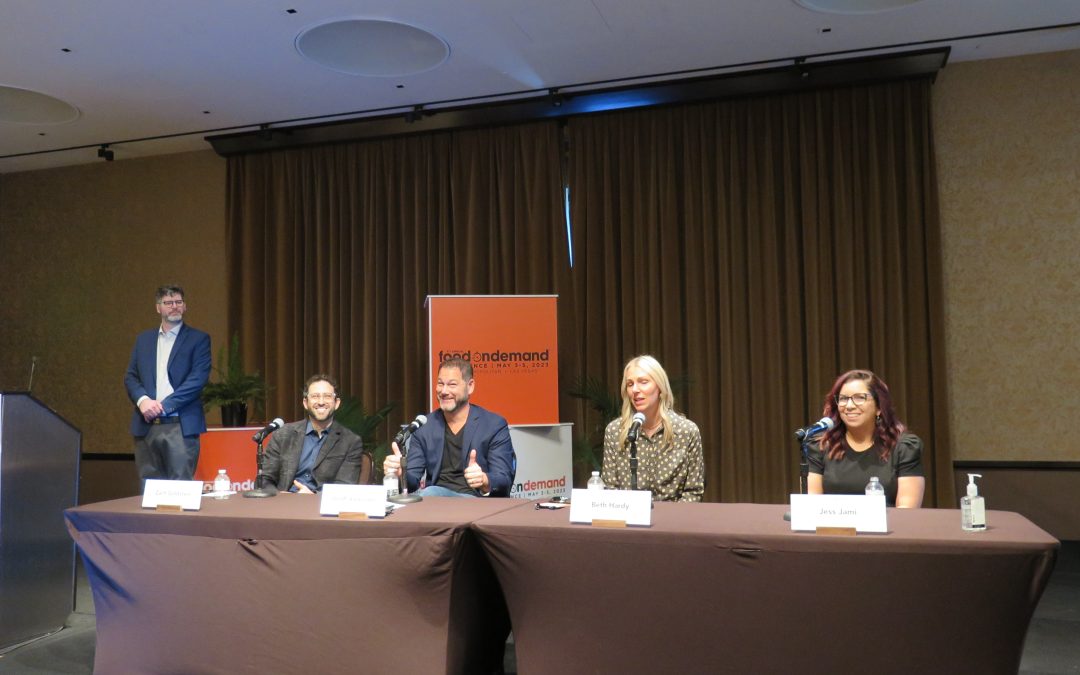Restaurant operators aren’t necessarily big fans of third-party delivery providers—those fees! that data-hoarding!—and a provocatively named panel dug into the topic at the Food On Demand Conference. “Future Battlegrounds of Data, Delivery and Loyalty,” was its title.
“It’s been critical since the arrival of third-party delivery that restaurants prioritize owning direct relationships with their customers,” said Zach Goldstein, founder of Thanx, which creates and manages guest engagement and retention programs for restaurant customers.
“We’ve seen this in other industries.” In the past, customers could book a room at the Hilton through Expedia and still received Hilton loyalty points. “You book on Expedia now, Hilton puts you in the basement,” he said.
“There was a period when we were debating” whether operators “should take price on delivery. The new battleground is around advertising. And the reality is you may be doing excellently on third-party delivery today, and that might change if you stop paying” advertising fees. “It’s not enough today” to provide superior food and high-quality service. “You also have to be maintaining the direct digital relationship with your customer, or you’re at their whim,” Goldstein said.
Geoff Alexander, president and CEO of Asian street food vendor Wow Bao, said third-party delivery is “completely based on relationships. The problem is, the relationship you’re losing is with the guest. You need to have relationships with your guest, and you need to build trust, and it’s very difficult. You have DoorDash laying off people. Grubhub has a new CEO,” he said, referring to recent news reports.
In the past, delivery providers could tell operators how much of their sales was attributed to their spend. “Now they’re saying, we don’t know how to help you spend the money.’ And they’re losing people on their team. The problem with the third parties we’re running into, is it’s very difficult to communicate with third parties. We’re a pretty large vendor, and we don’t have a single phone number to anybody” to contact.
“It’s a jumbled web we’re in right now. There’s a lot of excitement in what’s going on in the third parties, but it’s almost a minefield you’re walking through,” Alexander said.
Asian restaurant chain P.F. Chang’s was into delivery well before the pandemic, launched an in-house driver fleet in 2019 and most recently launched a subscription model, said Jessica Jami, director of off-premises dining operations.
Premier subscribers who pay $6.99 a month don’t get discounts but do get extra benefits. “The delivery and service fee are waived, if they’re platinum guests. We also have a premium wait list. So, if you come in the restaurant and there’s an hour wait, you get bumped up third to the top.” If subscribers can’t get a reservation, “if you’re a VIP we’ll make a reservation when you want,” she said. The goal: “Really speaking to the guests in all forms they’re at. Giving them extra value without having to discount it.”
Jami said for her the goal is optimization. “Optimization is key to anything you’re doing. For us, the not discounting, the focusing on loyalty, the looking towards subscription—it’s how do we get guests to keep coming back.?”
P.F. Chang’s partnered with Cartwheel starting in 2019 to do their own delivery, and customers responded. “Once they realize you’re the ones delivering it, they’re really happy with that. We go in uniform, we have car toppers. Those guests see that and it drives them to our website and they’re more likely to give repeat orders to us,” she said.
P.F. Chang’s also still advertises for prime placement on the third parties’ platforms. How do they balance that versus gaining direct customers? “We have a different strategy for our direct guests or our native channel” than for the third party. “So, you understand what benefits you. There are staunch third-party customers and they’ll never come direct to us,” so they don’t spend resources on trying to make them switch.
Beth Hardy is vice president of marketing for Modern Market Eatery and Lemonade, two separate brands with about 50 units between them, both in growth mode. “Lemonade is only in California. Modern Market has locations in Colorado, Texas and Arizona. When we do open a new market, we have to be strategic, knowing that many guests have never heard of us before,” she said. “So, third party is one way to drive awareness to us. We’ve always thought about third party as a marketing tool.”
When entering new markets, “maybe we have a higher ad budget. Maybe we’re always on. Maybe our promos are a little bit richer for new markets. For existing, that might be the inverse of what we do in new markets,” Hardy said.
Modern Market Eatery this week rolled out a points system for their loyalty program. “It is a great way to incentivize guests to think about us versus other brands,” Hardy says. All restaurants have to have great food and service and atmosphere. “So, what’s the difference? Maybe it’s having a robust loyalty program. Maybe it’s gamifying it.” With the recent points rollout, “I’m excited to be able to offer that to our guests. We have an interesting loyalty program that’s maybe better than the restaurant next door,” Hardy said.
For Goldstein at Thanx, the key for operators is to be unafraid to try. “We don’t know what works. Across our customers we’re probably running close to billions of campaigns. I don’t know what works. The only way to know is to test it. Whether it’s $3 or $4” off a pack of dumplings, or “whether it’s a secret menu item” available only to members, “it requires taking that leap.” A lot of operators are waiting to find someone to prove it to them. “No one can prove it to you.”
Wow Bao’s Alexander says: “It’s trial and error. It’s being able to say, how nimble am I going to be?”
The sixth annual Food On Demand Conference continued through May 5 at the Cosmopolitan in Las Vegas.


